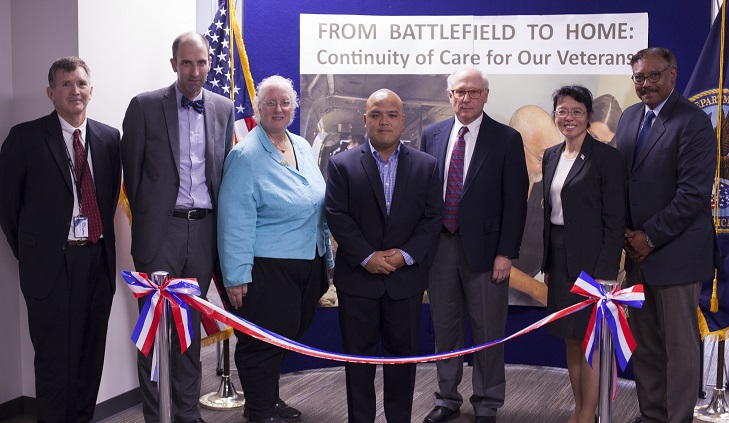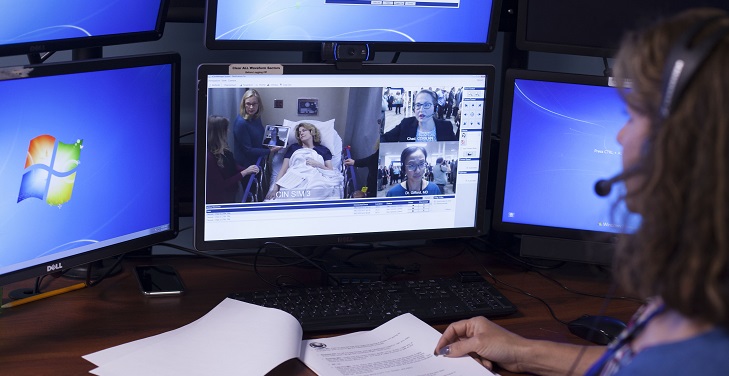There is a medical revolution happening on the quiet second floor of the John Weld Peck Federal Building in Cincinnati, Ohio. There, behind an unassuming beige door, VA telehealth physicians and nurses at high-tech workstations deliver care to Veterans at 19 medical facilities across the country.
“We are actually making the future of telehealth right here,” said Dr. Ralph Panos, the Tele-ICU medical director for VISN 10, at the Sept. 27 ribbon-cutting event that marked the opening of VISN 10’s new Tele-ICU facility.
VISN 10’s Tele-ICU program has come a long way since it began in 2011 at the Cincinnati VA Medical Center. The modest staff of six nurses, three physicians, and one part-time biotech engineer has become a team of 47 registered nurses, five advanced practice nurses, 14 physicians, and six supporting staff members.
During his opening speech, Panos reflected on the Tele-ICU program’s journey and recognized the many hands that helped to build the program as it stands today. “They say it takes a village to raise a child. It takes a nation to grow a Tele-ICU,” he said.
“Health care is no longer an individual enterprise,” said Dr. Neil Evans, chief officer for VA’s Office of Connected Care. “It is a team sport.”
While Tele-ICU can support 30 to 40 Veterans for each telehealth nurse and 120 for each physician, its real impact, said Evans, extends beyond this capacity to the sense of calm it brings to the sometimes-chaotic environment of an ICU.
“The fact that a clinical staff member or a family member can press a button on a wall in an ICU hundreds of miles from here, and a calm voice can come on, someone who has all of the tools to help out — the value of that cannot be overstated,” Evans said.
The event’s keynote speaker was Hein Tran, a former infantry staff sergeant. “This Tele-ICU center that you have here today, that is a beacon of hope,” he said.
Now a successful entrepreneur and mentor to transitioning Veterans, Tran reflected on his lengthy recovery from a roadside bomb blast which left him with a slew of injuries. Despite the frustrations he experienced during his 15-month recovery, he remains deeply grateful to the staff who helped him through that difficult period.
“The VA system is not what healed me,” Tran said. “It’s you guys. It’s the people.”
In addition to the ribbon-cutting, the event featured two medical simulations that demonstrated the capabilities of Tele-ICU. One was a stroke case that showed collaboration between a Tele-ICU physician, a TeleStroke neurologist, and the in-person team at the Veteran’s bedside.
“To be honest, I think it’s probably one of the first combinations of two telehealth modalities simultaneous with the bedside” said Panos about the stroke simulation. “That’s the opportunity that is available with this program.”
The other simulation was a straightforward example of how the telehealth nurse and physician interact with and support local ICU staff, the Veteran, and the Veteran’s family members. Together, both simulations showed how Tele-ICU can be useful to understaffed medical centers.
“Thirty years ago, there was not a Tele-ICU,” said Denise Dietzen, the Acting Network Director for VISN 10. “And I wish there was.”
Dietzen, a former VA nurse and medical center director, talked about her time working at facilities in rural Michigan, where they often had difficulty finding and retaining the right staff members and specialists. Recalling the frustration of not being able to offer patients the care they needed, she praised the VA employees who are pushing the limits of the technology.
Dietzen concluded her remarks with a quote often attributed to cultural anthropologist Margaret Meade: “Never doubt that a small group of thoughtful, committed citizens can change the world. Indeed, it is the only thing that ever has.”

Connected Care, VISN 10 and Cincinnati VAMC leaders take part in the VISN 10 Tele-ICU ribbon cutting ceremony at the Cincinnati VAMC.
About VA Tele-ICU: VA’s Tele-ICU program grew out of network initiatives within VISNs 10 and 23 in 2011–12. Today, the program supports 36 medical centers in 12 VISNs and at one Department of Defense site. Nearly 1-in-5 VA ICU beds is now equipped with Tele-ICU technology. The program served more than 7,000 patients last year and continues to expand.
Topics in this story
More Stories
Study underscores important role COVID vaccination can have in protecting Veterans from infection and reducing long-term health consequences
Columbia VA’s robotic surgery teams completed their 800th robotic surgery and are on schedule to hit 1,000 by the end of the year.
In a decentralized clinical trial, Veterans can participate from their own homes or local VA instead of having to travel to a research site.







It is great to see innovations like ICU telemed bring real results to real people in real-time. This shortens the time to critical care delivery in a meaningful way!
The software is pretty smart.
So what it’s doing is it’s always combing through the patient’s medical records, looking for triggers. it is right?